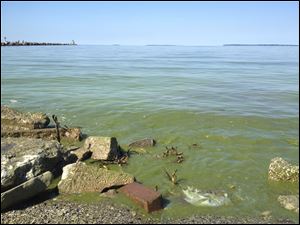
Expert: CAFOs’ effects on water less than thought
Area activists dispute statements
8/19/2016GIBRALTAR ISLAND, Ohio — CAFOs, mega-livestock facilities large enough to be classified as concentrated animal-feeding operations, may not impact western Lake Erie water quality as much as some activists think, an expert said Thursday.
Laura Johnson, director of the Heidelberg University’s National Center for Water Quality Research, said that although more soil testing is needed, she hasn’t found anything in the center’s set of stream data that suggests manure generated by CAFOs is being over-applied to area farms.
“We don’t have evidence of over-application of manure now in the western Lake Erie basin,” according to Ms. Johnson, a phosphorus researcher who was named the center’s director in February. “The influence of livestock density is not a clear-cut issue.”
Ms. Johnson made her comments during the first day of an annual, two-day workshop for science writers hosted by Ohio State University’s Stone Laboratory on Gibraltar Island, near Put-in-Bay.
Algae is one of several issues being discussed.
With a data set going back to 1969, Heidelberg’s National Center for Water Quality Research has some of the most extensive records of farm runoff in the Great Lakes region. It draws samples from numerous Ohio sites and one in Michigan three times a day.
But Ms. Johnson concedes many of the center’s sampling sites are outside of western Lake Erie’s most CAFO-dense areas, which are in extreme western parts of Ohio, as well parts of southeast Michigan and northeast Indiana.
She said her best CAFO data comes from phosphorus numbers along the Maumee River near Waterville, the River Raisin, and the Tiffin River.

The Lake Erie shoreline in Port Clinton teemed with green algae in 2014.
Ohio’s strongest cause and effect between CAFOs and algae is Grand Lake St. Marys, which the Heidelberg lab also samples. But Ms. Johnson said the problem is from a legacy of over-application of manure in that area, and that it will take years for soil there to return to normal.
“It’s because of the history of soil application there,” she said, asserting that Grand Lake St. Marys is an unusual situation.
Statewide, about 20 percent of farmland is either enriched with too much phosphorus or doesn’t need more of that nutrient, Ms. Johnson said. Records also show the agricultural industry has been buying less commercially manufactured fertilizer in recent years and applying more manure.
But she said manure can be an affordable fertilizer — if applied responsibly.
Groups such as Environmentally Concerned Citizens of South Central Michigan strongly disagree, documenting hundreds of violations at area farms and successfully campaigning for more government tests of area streams after doing their own.
One of that group’s early members, Lynn Henning, won the 2010 Goldman Environmental Prize. With a cash award of $150,000, the Goldman Prize is Earth’s largest for environmental activism.
CAFOs have been targeted by former Toledo councilman and two-time mayoral candidate Mike Ferner, who founded a group called Advocates for a Clean Lake Erie in response to the 2014 Toledo water crisis. Adding to the chorus has been Sandy Bihn, Lake Erie Waterkeeper founder, and J. Patrick Nicholson, N-Viro founder and a former Toledo Lucas County Port Authority president.
“The number of poultry in Ohio reported to the U.S. Department of Agriculture was 11 million in 1982 and 91 million in 2012 — and since 2012 there are reports of at least 10 million more poultry in the Maumee watershed. Manure phosphorus in the soil is allowed at about four times what is allowed for commercial fertilizer,” Ms. Bihn said. “The statement from Heidelberg is an opinion — the facts support that manure is a major component of the Lake Erie algae source problem.”
Mr. Ferner said the western Lake Erie basin’s 146 CAFOs produce the manure equivalent of sewage generated by the cities of Los Angeles and Chicago.
“When sampling is done all the way up all the headwaters of streams flowing into the Maumee River and not just in a few rivers, the animal waste problem will simply shock people,” he said.
Bill Harke, spokesman for Milk Source, a Wisconsin-based company that purchased the troubled Vreba-Hoff dairies in Michigan’s Lenawee County, said Ms. Johnson’s findings “reflect the dedication and hard work of today’s innovative farming community of which we are proud to be a part.”
Contact Tom Henry at: thenry@theblade.com, 419-724-6079, or via Twitter @ecowriterohio.